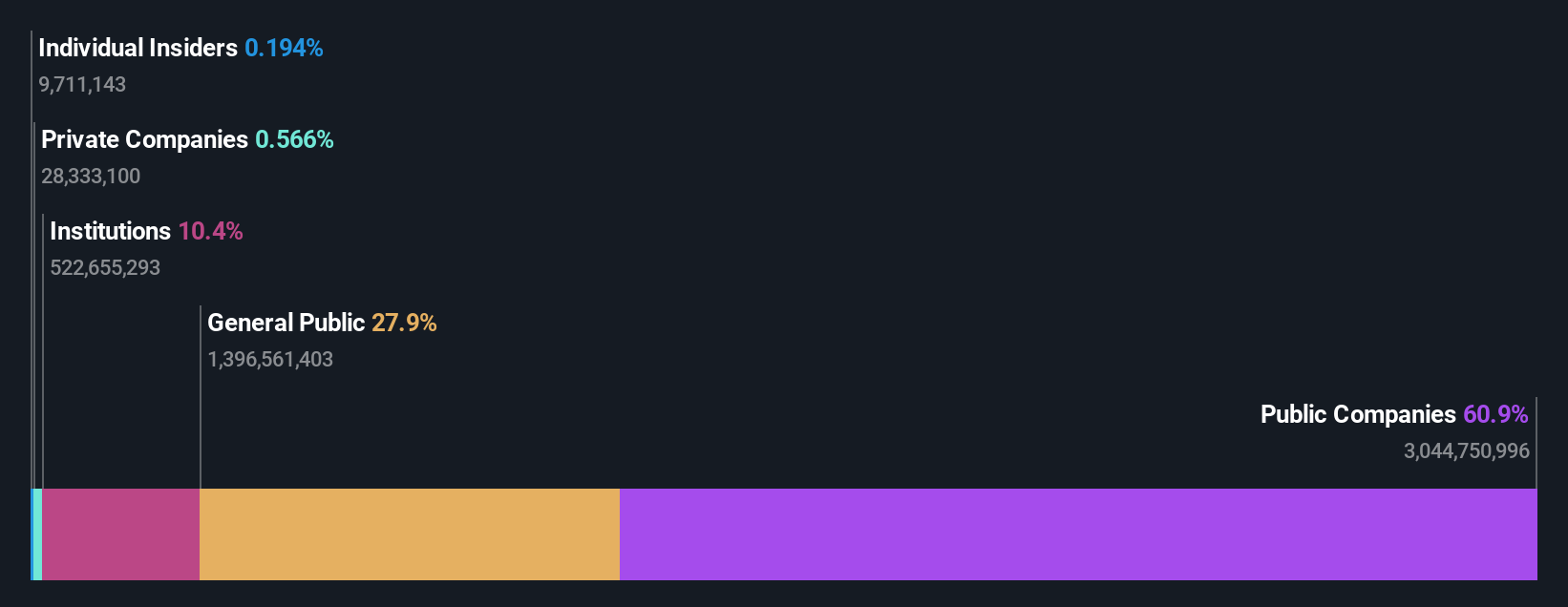- Hong Kong
- /
- Real Estate
- /
- SEHK:101
Individual investors own 28% of Hang Lung Properties Limited (HKG:101) shares but public companies control 61% of the company
Key Insights
- The considerable ownership by public companies in Hang Lung Properties indicates that they collectively have a greater say in management and business strategy
- The largest shareholder of the company is Hang Lung Group Limited with a 61% stake
- Insiders have been buying lately
Every investor in Hang Lung Properties Limited (HKG:101) should be aware of the most powerful shareholder groups. With 61% stake, public companies possess the maximum shares in the company. Put another way, the group faces the maximum upside potential (or downside risk).
Meanwhile, individual investors make up 28% of the company’s shareholders.
In the chart below, we zoom in on the different ownership groups of Hang Lung Properties.
See our latest analysis for Hang Lung Properties

What Does The Institutional Ownership Tell Us About Hang Lung Properties?
Many institutions measure their performance against an index that approximates the local market. So they usually pay more attention to companies that are included in major indices.
As you can see, institutional investors have a fair amount of stake in Hang Lung Properties. This can indicate that the company has a certain degree of credibility in the investment community. However, it is best to be wary of relying on the supposed validation that comes with institutional investors. They too, get it wrong sometimes. When multiple institutions own a stock, there's always a risk that they are in a 'crowded trade'. When such a trade goes wrong, multiple parties may compete to sell stock fast. This risk is higher in a company without a history of growth. You can see Hang Lung Properties' historic earnings and revenue below, but keep in mind there's always more to the story.

Hang Lung Properties is not owned by hedge funds. Looking at our data, we can see that the largest shareholder is Hang Lung Group Limited with 61% of shares outstanding. With such a huge stake in the ownership, we infer that they have significant control of the future of the company. The Vanguard Group, Inc. is the second largest shareholder owning 1.5% of common stock, and Norges Bank Investment Management holds about 0.9% of the company stock.
Researching institutional ownership is a good way to gauge and filter a stock's expected performance. The same can be achieved by studying analyst sentiments. Quite a few analysts cover the stock, so you could look into forecast growth quite easily.
Insider Ownership Of Hang Lung Properties
While the precise definition of an insider can be subjective, almost everyone considers board members to be insiders. Company management run the business, but the CEO will answer to the board, even if he or she is a member of it.
Most consider insider ownership a positive because it can indicate the board is well aligned with other shareholders. However, on some occasions too much power is concentrated within this group.
Our most recent data indicates that insiders own less than 1% of Hang Lung Properties Limited. It is a pretty big company, so it would be possible for board members to own a meaningful interest in the company, without owning much of a proportional interest. In this case, they own around HK$65m worth of shares (at current prices). Arguably, recent buying and selling is just as important to consider. You can click here to see if insiders have been buying or selling.
General Public Ownership
The general public, who are usually individual investors, hold a 28% stake in Hang Lung Properties. While this size of ownership may not be enough to sway a policy decision in their favour, they can still make a collective impact on company policies.
Public Company Ownership
We can see that public companies hold 61% of the Hang Lung Properties shares on issue. It's hard to say for sure but this suggests they have entwined business interests. This might be a strategic stake, so it's worth watching this space for changes in ownership.
Next Steps:
While it is well worth considering the different groups that own a company, there are other factors that are even more important. Case in point: We've spotted 2 warning signs for Hang Lung Properties you should be aware of.
If you are like me, you may want to think about whether this company will grow or shrink. Luckily, you can check this free report showing analyst forecasts for its future.
NB: Figures in this article are calculated using data from the last twelve months, which refer to the 12-month period ending on the last date of the month the financial statement is dated. This may not be consistent with full year annual report figures.
Valuation is complex, but we're here to simplify it.
Discover if Hang Lung Properties might be undervalued or overvalued with our detailed analysis, featuring fair value estimates, potential risks, dividends, insider trades, and its financial condition.
Access Free AnalysisHave feedback on this article? Concerned about the content? Get in touch with us directly. Alternatively, email editorial-team (at) simplywallst.com.
This article by Simply Wall St is general in nature. We provide commentary based on historical data and analyst forecasts only using an unbiased methodology and our articles are not intended to be financial advice. It does not constitute a recommendation to buy or sell any stock, and does not take account of your objectives, or your financial situation. We aim to bring you long-term focused analysis driven by fundamental data. Note that our analysis may not factor in the latest price-sensitive company announcements or qualitative material. Simply Wall St has no position in any stocks mentioned.
About SEHK:101
Hang Lung Properties
An investment holding company, engages in the property investment, development, and management activities in Hong Kong and Mainland China.
Mediocre balance sheet with limited growth.
Similar Companies
Market Insights
Community Narratives




